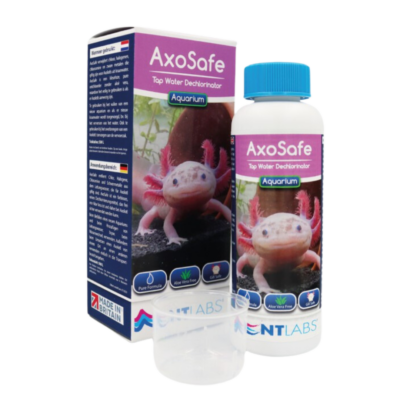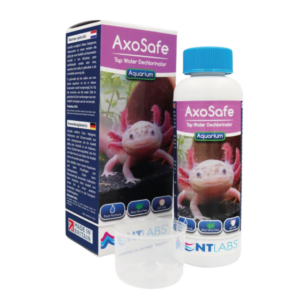NT Labs AxoSafe 100ml
£4.89
- Description
- Additional information
Description
NTLabs AxoSafe 100ml
Created for axolotl aquariums, removes chlorine, chloramine & heavy metals, reduces stress
When to use:
AxoSafe removes chlorine, halogens, chloramine and heavy metals found in tap water, which are toxic to Axolotls. AxoSafe is a colourless, pure dechlorinator which is free from aloe vera making it safe for use when Axolotls are present.
Use when filling a new aquarium and when adding fresh tap water i.e. during a water change. Also use when moving an Axolotl from one place to another: simply add to the transport bags.
Do:
- Calculate the volume of your aquarium in litres (length x width x depth (in cm)/1000). Alternatively visit: www.ntlabs.co.uk/dosage-calculator and we will calculate it for you.
- Shake the bottle thoroughly before use.
- Mix required dose in the new water before adding it to the aquarium.
- Add slowly to aquarium.
- Product works immediately to remove chlorine and chloramines from tap water.
Dose:
- 10ml to 50 litres of aquarium water.
The axolotl (Ambystoma mexicanum) is a neotenic salamander, meaning it retains its larval features throughout adulthood. It is native to Lake Xochimilco and Lake Chalco in Mexico City, but both lakes are now highly polluted and fragmented, and the axolotl is critically endangered in the wild.
Axolotls are known for their unique appearance, with large heads, feathery gills, and long tails. They can be a variety of colors, including pink, white, brown, and black. Axolotls are also known for their regenerative abilities, and can regrow limbs, tails, and even parts of their brains.
Habitat
Axolotls are aquatic animals and live in lakes, ponds, and canals. They prefer cool, well-oxygenated water with a muddy bottom. Axolotls are nocturnal animals and spend the day hiding in rocks and plants. At night, they come out to feed.
Diet
Axolotls are carnivores and eat a variety of aquatic invertebrates, including worms, insects, crustaceans, and small fish. They also eat other axolotls, especially juveniles. Axolotls have poor eyesight, so they rely on their sense of smell to find food. They suck in their food through their small mouths.
Conservation
Axolotls are critically endangered in the wild due to habitat loss, pollution, and invasive species. However, axolotls are bred in captivity all over the world, and there is a growing interest in keeping them as pets.
For more information please see our guides section.
In need of inspiration? Check out our Instagram feed.
Additional information
| Weight | 0.1 kg |
|---|---|
| GTIN | |
| Volume | |
| EAN | |
| Brand |






